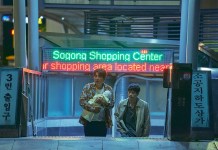Matteo Garrone has a history of directing fascinating films that vary from the gritty Gomorrah to the fantastical Tale of Tales (which screened here in Cannes in 2015). Dogman, based on a true crime story, fits snugly into the former category, yet it is also a fable for modern times.
The dog man in question is Marcello (Marcello Fonte), a diminutive dog groomer and petty criminal who dabbles in coke dealing to make ends meet. His home and shop are in Villaggio Coppola, a dilapidated seaside town with jerry-built buildings and a sense of social deprivation. Yet there is also a strong sense of community here: the shop owners are all pals and the men organise regular football matches. Marcello is well liked and even seems to have a good relationship with his ex, the mother of his beloved daughter Sofia. Yet all is not peace and love in this rundown town, due to the presence of Simoncino (Edoardo Pesce), a hulking brute of a man who terrorises the neighbourhood. There is a magnificent scene when Simoncino first appears at Marcello’s shop and we see him snorting coke in the bathroom, his silhouette looming over Marcello through the bathroom glass door like something from a nightmare.
Marcello’s relationship with Simoncino is a complex one: he is threatened by this thug, yet at the same time wants to be his friend. He knows that everyone wants to be rid of Simoncino, but saves his life rather than allowing him to die. Another memorable scene involves the two men attending a strip joint in which all the girls are dressed as angels. Marcello looks like he has died and gone to heaven.
There is also humour here, courtesy of this very odd couple (and Simoncino’s mum). In fact, despite its gory ending, Dogman is full of gentle humour. The dogs who are Marcello’s clients provide much of this, as does his pet dog Jack. The scene of Marcello and Jack having dinner together is a treat and Jack must be a strong contender for the Palme Dog award this year. Fonte looks like a canine pro and seems to have real affinity with the animals in the film.
Garrone says he wanted the film to resemble an urban Western and this little town definitely depicts a sense of the traditional one-horse town, with its saloon bar, deserted streets and sun-scorched buildings. Garrone’s DOP Nicolai Brüel has created an amazing palette: the film is bathed in tepid sunshine at the beginning of the film, but after Marcello’s incarceration the colours are greyer and darker as the story moves towards its inexorable denouement.
The two leads are outstanding. As Marcello, Fonte imbues his character with warmth and humanity. His descent and fall from grace are etched onto his features as he loses his friends and his social standing. And as Simoncino, Pesce has provided us with a terrifying monster; a man who knows no restraint and cannot be corralled until the very end, when he is caged like a wild beast in Marcello’s store. Garrone states that he was interested in representing the weak and how fear is at the heart of the story. Marcello is stick-thin, short and broke, but he has a lot: the love of his family and friends. But he fears speaking out, he fears reprisals, and fears losing face. Marcello Fonte portrays the essence of this fragile, gentle man who in order to slay a monster becomes something of a monster himself.










